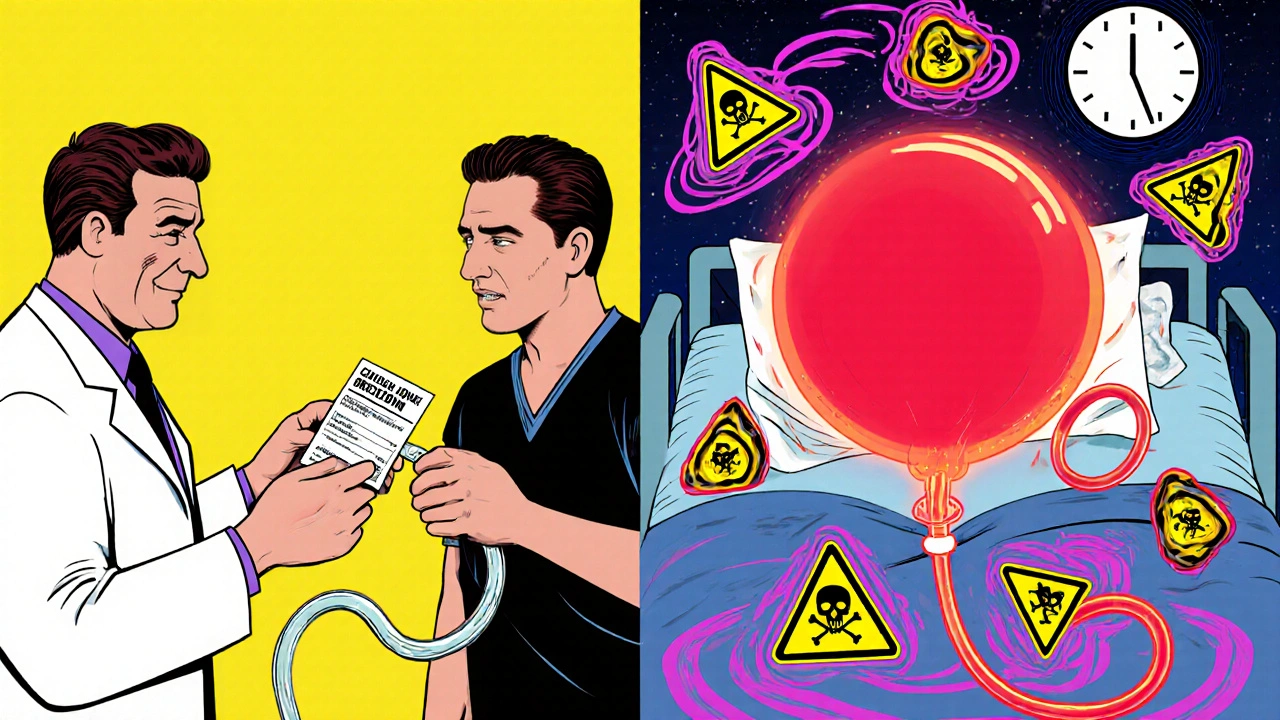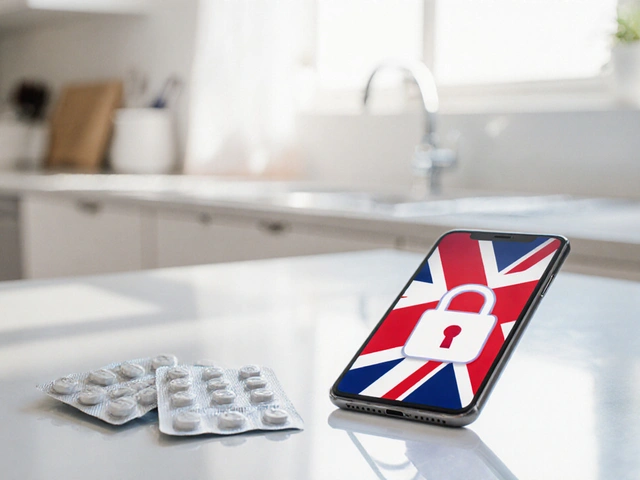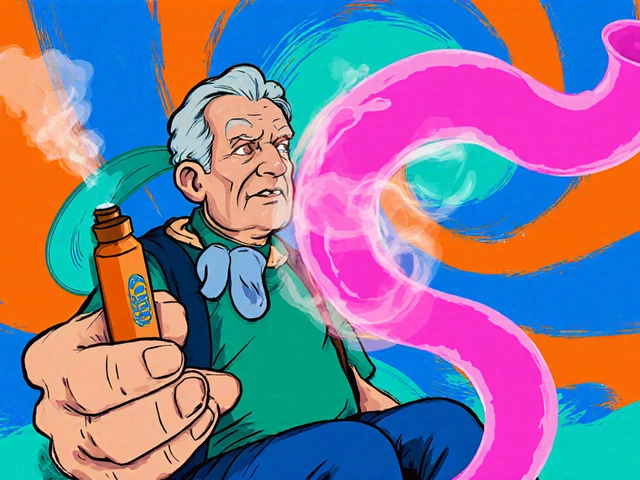Anticholinergic Urinary Retention Risk Calculator
Risk Assessment Tool
Imagine taking a pill for an overactive bladder, only to find yourself unable to pee at all. No warning. No gradual warning signs. Just sudden, painful complete blockage - and a catheter needed to fix it. This isn’t rare. It happens more often than most doctors admit, especially in men over 65. And the culprit? Common medications you might not even think twice about.
How Anticholinergics Stop Your Bladder from Working
Your bladder doesn’t empty on its own. It needs a signal - acetylcholine - to tell the main muscle (the detrusor) to squeeze. Anticholinergic drugs block that signal. They’re designed to relax the bladder so you don’t feel the urgent need to go. But in doing so, they can stop the bladder from squeezing hard enough to empty. That’s urinary retention: urine stays behind, building up in the bladder. It’s not just about feeling full. The real danger is when residual urine hits 150 mL or more. That’s the threshold where infection, kidney damage, and acute retention become likely. And anticholinergics are among the top offenders. A 2008 study found that up to 10% of all urinary retention cases are caused by medications - and anticholinergics are the biggest group.Not All Anticholinergics Are the Same
Some anticholinergics are riskier than others. Oxybutynin, one of the oldest and still widely used, blocks all three main muscarinic receptors - M1, M2, and M3. That means it doesn’t just affect the bladder. It hits the brain, the mouth, the gut. And it’s the most likely to cause retention. Studies show men with enlarged prostates on oxybutynin have a 3.2 times higher risk of retention compared to those on placebo. Newer drugs like darifenacin and solifenacin are more selective. They target mainly the M3 receptor, which is the one that triggers bladder contraction. That sounds better - and it is. Solifenacin has a retention rate of 1.2-1.8%, while oxybutynin’s is 1.8-2.5%. But even “safer” ones aren’t safe for everyone. Trospium chloride is another option. It doesn’t cross the blood-brain barrier easily, so it causes less confusion or dry mouth. But it still carries a 1.5-2.2% risk of retention. And if you’re over 65, have an enlarged prostate, or take other meds - that risk jumps.Who’s Most at Risk?
Men over 65 with benign prostatic hyperplasia (BPH) are the most vulnerable. Their prostate already squeezes the urethra. Add an anticholinergic? The bladder can’t push past the blockage. The risk of retention in this group? Around 4.3%. That’s nearly 1 in 23 men. Women aren’t immune. But their risk is lower - about 5.1% compared to 12.3% in men. Why? No prostate. But if a woman has weak bladder muscles, nerve damage from diabetes, or prior pelvic surgery, she’s still at risk. Older adults with dementia? The Beers Criteria lists anticholinergics as “potentially inappropriate.” Why? Because they raise the chance of urinary retention by 49% - and also cause confusion, falls, and memory loss. A 2016 JAMA study showed these drugs are a triple threat: bladder, brain, and balance.What Happens When It Goes Wrong?
Acute urinary retention means you can’t pee at all. It’s an emergency. You’ll need a catheter - and often a hospital visit. In the U.S., anticholinergic-induced retention costs $417 million a year in ER visits and procedures. Chronic retention is sneakier. You pee, but not fully. You feel like you’re never done. You dribble. You get up twice at night. Your bladder gets stretched. Over time, it loses tone. You might not even notice until you get a UTI or kidney infection. Real stories back this up. On Drugs.com, a 68-year-old man wrote: “After two weeks of oxybutynin, I couldn’t pee. Catheterized. My urologist said this happens in 1 in 50 men like me.” On Reddit, over 120 posts since 2020 describe similar emergencies after starting tolterodine or solifenacin.
What Should You Do Before Starting These Drugs?
If you’re considering an anticholinergic for overactive bladder, ask your doctor for a post-void residual (PVR) test. This is a simple ultrasound scan that measures how much urine is left after you pee. It takes 5 minutes. No needles. No pain. The American Urological Association says: Never start an anticholinergic without a baseline PVR. If your residual is over 150 mL, don’t take it. Period. Even 100 mL is a red flag. If you’re already on one, get checked every month for the first three months. Then every three months. If your PVR climbs above 150 mL, stop the drug. Don’t wait for symptoms.Alternatives That Don’t Block Your Bladder
There are safer options. Mirabegron (Myrbetriq) works differently. It relaxes the bladder muscle by activating beta-3 receptors - not blocking acetylcholine. Its retention rate? Just 0.3%. That’s less than one-third of anticholinergics. OnabotulinumtoxinA (Botox injections into the bladder) is another alternative. It paralyzes the muscle just enough to reduce urgency. Retention risk? Only 0.5%. But it needs a specialist to do it, and you might need to self-catheterize for a few weeks afterward. Peripheral neuromodulation (like PTNS or InterStim) uses mild electrical pulses to retrain bladder nerves. No drugs. No catheters. Just a small probe near the ankle or a tiny implant. Success rates are high, and retention risk? Virtually zero.What If You’re Already on an Anticholinergic?
If you’re taking one and haven’t had a PVR test - get one now. Don’t wait for trouble. If you’ve had any of these symptoms:- Straining to start urinating
- Weak or slow stream
- Feeling like you haven’t finished
- Needing to push or bear down
- Urinating more than 8 times a day
- Waking up twice or more at night to pee

The Bigger Picture: Why This Keeps Happening
Anticholinergics are cheap. They’ve been around for decades. Many doctors still prescribe them because they’re familiar. But the data has changed. In 2015, 58% of overactive bladder prescriptions were anticholinergics. By 2022, that dropped to 44%. Mirabegron now holds 31% of the market. The FDA now requires black box warnings on all anticholinergics about urinary retention. Medicare penalizes hospitals for retention cases linked to these drugs. European regulators banned them outright in patients with a history of retention. New tools are emerging. The Anticholinergic Risk Calculator (ARC), launched in 2023, uses your age, prostate size, baseline PVR, and other meds to predict your personal risk - with 89% accuracy. Genetic testing for CHRM3 receptor variants is also in early use. If you have certain genes, your risk is nearly five times higher.What to Ask Your Doctor
Don’t leave this to guesswork. Ask:- “Is this drug necessary? Are there safer alternatives?”
- “Have you checked my post-void residual?”
- “What’s my risk of retention based on my prostate size and other meds?”
- “If I start this, how often will you check my bladder emptying?”
- “What are the warning signs I should never ignore?”
Bottom Line: Your Bladder Can’t Wait
Anticholinergics aren’t the villain - but they’re not the hero either. They’re a tool. And like any tool, they can be dangerous in the wrong hands. If you’re over 65, male, or have any history of urinary issues, this isn’t a gamble you should take. Your bladder is not a luxury. It’s a vital organ. Don’t let a pill meant to help you end up trapping urine inside you. Ask for the test. Ask for the alternative. And if you’re already on one - get your PVR checked today. It could save you from a catheter, a hospital stay, or worse.Can anticholinergic drugs cause permanent bladder damage?
Yes, if urinary retention is left untreated for weeks or months, the bladder muscle can stretch and lose its ability to contract properly. This is called detrusor underactivity. Once this happens, you may need to self-catheterize permanently, even after stopping the medication. Early detection through PVR testing can prevent this.
Are there any over-the-counter anticholinergics I should avoid?
Yes. Many OTC sleep aids, allergy meds, and stomach remedies contain anticholinergics like diphenhydramine (Benadryl), chlorpheniramine, or oxybutynin in low doses. These are often labeled as “for nighttime use” or “for overactive bladder.” If you’re over 65 or have prostate issues, avoid these completely. Even one pill can trigger retention.
Why do some doctors still prescribe anticholinergics if they’re so risky?
Many doctors learned to treat overactive bladder with anticholinergics decades ago, and habits are hard to change. Also, mirabegron and Botox are more expensive and require more time to explain. But guidelines have shifted. The American Urological Association now recommends anticholinergics only after safer options fail - especially in men.
Can I take an anticholinergic if I’m a woman with no prostate issues?
Women without bladder outlet obstruction have a lower risk - around 5% - but it’s not zero. If you have nerve damage from diabetes, past pelvic surgery, or weak bladder muscles, you’re still at risk. Always get a PVR before starting. And if you notice any trouble emptying, stop the drug and call your doctor.
How do I know if I have a high anticholinergic burden?
The Anticholinergic Cognitive Burden (ACB) scale scores each drug from 1 to 3. A score of 3 means high risk. If you’re taking multiple drugs with ACB scores of 2 or 3 - even if they’re for different things - your total burden adds up. A score of 3 or higher increases your risk of urinary retention by 68%. Ask your pharmacist to calculate your total ACB score.
Is it safe to combine anticholinergics with alpha-blockers?
Combining them reduces retention risk by 37% compared to anticholinergics alone - but it’s not risk-free. Alpha-blockers help relax the prostate, while anticholinergics still weaken bladder contraction. You still need regular PVR checks. Many experts say: if you need both, you’re better off switching to mirabegron or Botox instead.




